Perhaps you have heard by now of the Sky Lanterns that populated the night air above Pere Marquette Beach on August 5th? You have not? Well, let me tell the tale…
It was a night not much different from the night that started it all: the night of the first Sky Lantern Incident (if you have not read that post, please read it first.) Peg was the prime mover for this event, as she is for most things involving beaches. It was to be another cookout on the beach, and Peg suggested we bring hot dogs, some extra firewood and maybe a few Sky Lanterns, just in case we felt brave. This suggestion produced an immediate chill in my bones. We had been lucky on our second sky lantern encounter, but Pere Marquette Beach was the site of our first near-disaster. The place that almost marked the turning point of life as I knew it.
All day long as the beach party time approached, I had watched the wind. The wind had proven on more than one occasion it was not my friend. Several times during the day, I went out on my deck to observe and to measure its strength. All day long it roared like a caged animal, frantically seeking a way out. An email arrived from Peg saying she and Jeff were not going to bring their kayaks because wind and wave conditions were too bad for kayaking. I knew the chances of finding a launch window in these conditions were poor. But I brought the lanterns anyway.
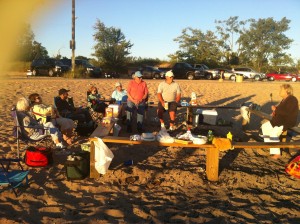 We began gathering at the beach for our cookout. The group slowly came together. Old friends and new. Arriving in separate vehicles and lugging bags and bundles of goodies and folding chairs. Eventually, hot dogs, marshmallows, corn, chips, salads, and other munchies were laid out on the benches for everyone to enjoy.
We began gathering at the beach for our cookout. The group slowly came together. Old friends and new. Arriving in separate vehicles and lugging bags and bundles of goodies and folding chairs. Eventually, hot dogs, marshmallows, corn, chips, salads, and other munchies were laid out on the benches for everyone to enjoy.
Jeff had taken responsibility for making fire. He brought dry wood and twigs carefully selected from his back yard. He then called on his Boy Scout memories and conjured up a magnificent fire. He even created a special pit for his fire to protect it from the wind, and he lit it without the customary use of Boy Scout water (white gas or kerosene), which naturally made him the envy of every guy present. It is a testament to his skill that the fire burned well. It had to because the wind was still showing great strength. On this occasion, we had two former Scout Masters (Steve H. and Dad), but with Jeff’s skill, no assistance was needed. Our meals were prepared and consumed with great gusto. Afterwards, things quieted down. And we began our vigil. The one thing no one had talked about. The one thing on everyone’s mind. The sky lanterns. And would they fly again tonight?
As dusk approached, the wind seemed to quiet down. The paparazzi began gathering. There were at least 6-7 of them in plain sight. They pretended to point their cameras at the sunset, but I knew why they were there. They had obviously been tipped by someone that we might try this again. Secretly, I wondered who among our ranks had betrayed us.
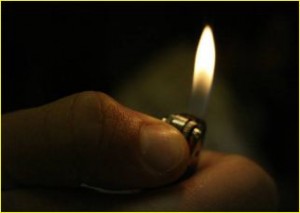 The absence of the wind was puzzling. Peg performed several high-tech wind measuring maneuvers with her lighter which confirmed this observation. I know at dusk the wind often changes direction. During the change, there is a brief calm. This might be the launch window we were seeking. It might also be another vicious trick.
The absence of the wind was puzzling. Peg performed several high-tech wind measuring maneuvers with her lighter which confirmed this observation. I know at dusk the wind often changes direction. During the change, there is a brief calm. This might be the launch window we were seeking. It might also be another vicious trick.
Someone said, “You really did bring the lanterns?” The question was asked with some temerity, and I thought I saw a couple of people wince when they heard these words. I said I brought four of them. Ardis, the bravest of the lot, blurted out that she had forgotten to bring her rubber gloves. Marge had apparently planned the same thing, but also forgotten. For a moment, I wondered if they planned to drive home to get them. Not wanting to lose any momentum, I went to the car to retrieve the lanterns. I returned with the four beauties I had selected earlier. At the fire pit, I carefully removed the wrappings and set them aside. I could feel their eyes on me.
But the time was not quite right. Before I could approve a launch, we had to await slightly more ideal conditions. This time, we would not just light a match and see what happened. This time we would consider wind speed, wind direction, visibility, proximity of innocent civilians, and other important things. Slowly, things seemed to come together. The only negative seemed to be the growing number of photographers who would record our every mistake and publish it on the internet for all to see.
When I announced it was time for the launch, I found we had doubters in the group. They still remembered our first failed launch attempt. They wanted a new location. A place far away from the Coast Guard Station. I found myself heartily agreeing with this suggestion, so we trekked down to the water’s edge and prepared our launch.
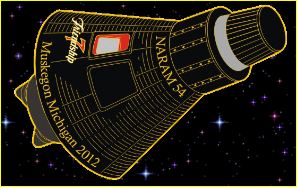 Jim and Dad and I had attended the National Rocket Convention in Muskegon earlier in the week, and I was full of inspiration. We learned all kinds of high-tech terms like “Prepare for Launch.” and “3-2-1-Launch!” and “Ignition Failure. Wait 60 seconds and try again.” and the all-important “Watch Out!” and “Duck!” and “Run!!!”. We knew so much more now than we had at the beginning of the summer. Back then, we were rank amateurs; now we were highly trained professionals. We knew all the necessary terminology. And we even had a successful launch under our belts. That is why we decided to up the ante.
Jim and Dad and I had attended the National Rocket Convention in Muskegon earlier in the week, and I was full of inspiration. We learned all kinds of high-tech terms like “Prepare for Launch.” and “3-2-1-Launch!” and “Ignition Failure. Wait 60 seconds and try again.” and the all-important “Watch Out!” and “Duck!” and “Run!!!”. We knew so much more now than we had at the beginning of the summer. Back then, we were rank amateurs; now we were highly trained professionals. We knew all the necessary terminology. And we even had a successful launch under our belts. That is why we decided to up the ante.
At the last successful launch, we sent up each new lantern only after 1) confirming the prior launch was successful, and 2) waiting until each lantern’s fire had flickered out. This time, we would do a sequential launch. With this in mind, we numbered each team from one to four.
Now, you mustn’t think a sequential launch is easy. It requires that all the team members know their jobs and be able to complete their tasks in a timely fashion. And, truth be told, there were some among us who had not yet been part of a successful launch. That was why when Cindy asked, “Are we going to let go all at once?”, I made an executive decision and said, “No. We are going to launch them in sequence!” I knew we had to do a successful sequential launch, before we could hope to master a simultaneous release launch. (See how easy it is to come up with technical terms?)
Team One was on deck. My two most seasoned veterans, Ardis and Jim, were ready. It was a good decision to lead with them. No words were necessary. They knew what needed to be done. I offered a quick light, and they did the rest. They took all their launching experiences and used it along with all the natural teamwork that comes from decades of successful marriage. The launch was so flawless that I forgot to take pictures.
Remember in the last post when I said Jim showed great management potential? By now, he was our greatest expert on optimum release timing. He could sense positive buoyancy in ways the rest of us could only imagine. When Jim said it was OK to release, you knew your baby was going for the moon!
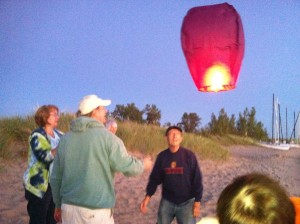 As I turned around, I found Team Two was eager to go. Steve H. and Cindy boldly moved into position. I admired them for their courage. They had never seen a successful launch and had only their memories of our failed attempts just two months ago. Yet they were ready. I lit the fire and moved back. I took up my camera as Jim moved forward to assist with the release. They worked together quickly and efficiently like the great team they are. And soon the second baby was adrift in the darkening sky.
As I turned around, I found Team Two was eager to go. Steve H. and Cindy boldly moved into position. I admired them for their courage. They had never seen a successful launch and had only their memories of our failed attempts just two months ago. Yet they were ready. I lit the fire and moved back. I took up my camera as Jim moved forward to assist with the release. They worked together quickly and efficiently like the great team they are. And soon the second baby was adrift in the darkening sky.
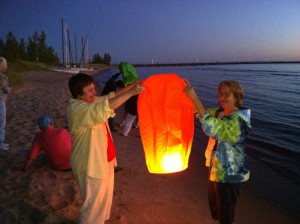 Team Three, consisting of the LeBel family, was the least organized of the group. Marge still seemed worried about fingerprints. Dad was sitting this one out. I was trying to take pictures. Cindy, flushed with her victory from but moments before, came forward to help. As the fire was lit, and the lantern began filling with hot air, I could see the mile-wide smiles on Marge and Cindy’s faces. This was to be the first all-girl launch ever. They were picturing their names in the Guinness Book of World Records, the world tours that would follow, the instant fame and notoriety, and the TV interviews. Steve H. and I will probably never know how close we came to losing them that night. Not surprisingly, their launch came off without a hitch.
Team Three, consisting of the LeBel family, was the least organized of the group. Marge still seemed worried about fingerprints. Dad was sitting this one out. I was trying to take pictures. Cindy, flushed with her victory from but moments before, came forward to help. As the fire was lit, and the lantern began filling with hot air, I could see the mile-wide smiles on Marge and Cindy’s faces. This was to be the first all-girl launch ever. They were picturing their names in the Guinness Book of World Records, the world tours that would follow, the instant fame and notoriety, and the TV interviews. Steve H. and I will probably never know how close we came to losing them that night. Not surprisingly, their launch came off without a hitch.
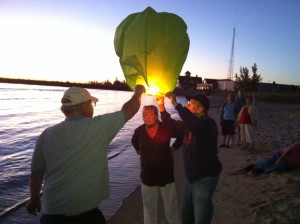 Team Four showed great initiative, and by the time I turned to evaluate and record their progress, Jeff and Peg had already achieved ignition. It was quickly reported, however, that the wick was only burning on one side, and several attempts to achieve a balanced burn had failed. Jim was brought in for a quick conference with the launch team, and they determined that if the release was delayed for a bit, they could still achieve a successful launch. And that is just the way it turned out. A launch to make anyone proud.
Team Four showed great initiative, and by the time I turned to evaluate and record their progress, Jeff and Peg had already achieved ignition. It was quickly reported, however, that the wick was only burning on one side, and several attempts to achieve a balanced burn had failed. Jim was brought in for a quick conference with the launch team, and they determined that if the release was delayed for a bit, they could still achieve a successful launch. And that is just the way it turned out. A launch to make anyone proud.
We remembered, somewhat belatedly, the lanterns were supposed to be sent up into the sky carrying a wish from the sender. For me, I was too busy giving thanks for trouble-free launches to think of anything to wish for. I hope others did better and their wishes come true.
And as I drove home that night, I felt the warm glow from work done well. I also felt a slight quickening of my heart when I remembered the six lanterns that still remained in my closet…

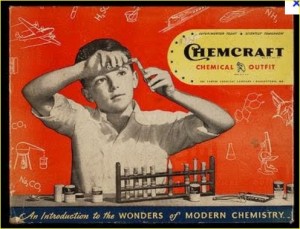
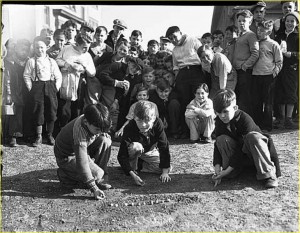 Fortunately, I was by far the best marble player at Lincoln School. Only Fred Herring could sometimes beat me, but not often. So, armed with a few more marbles, I went out to increase my wealth. And I knew all the tricks. As soon as my challenge was accepted, I would immediately say, “Triple Kings! Last all times!”, which guaranteed me the coveted right to go last for the duration of the game. Lots of kids, knowing my reputation, wanted to play “For Funs”, but I didn’t give in. It was “For Keeps” or nothing. And, of course, we all agreed that “Trades” were allowed because if you lost the game, you certainly didn’t want to lose your lucky marble, so you were allowed give up a similar marble of like quality. And, with every kid who would agree, we would put an extra marble or two in the pot to increase the stakes.
Fortunately, I was by far the best marble player at Lincoln School. Only Fred Herring could sometimes beat me, but not often. So, armed with a few more marbles, I went out to increase my wealth. And I knew all the tricks. As soon as my challenge was accepted, I would immediately say, “Triple Kings! Last all times!”, which guaranteed me the coveted right to go last for the duration of the game. Lots of kids, knowing my reputation, wanted to play “For Funs”, but I didn’t give in. It was “For Keeps” or nothing. And, of course, we all agreed that “Trades” were allowed because if you lost the game, you certainly didn’t want to lose your lucky marble, so you were allowed give up a similar marble of like quality. And, with every kid who would agree, we would put an extra marble or two in the pot to increase the stakes.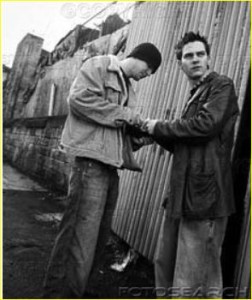 In four more days, I had what I needed to go back to my supplier. He was happy to see me. He’d even laid in a new supply in anticipation of my return.
In four more days, I had what I needed to go back to my supplier. He was happy to see me. He’d even laid in a new supply in anticipation of my return.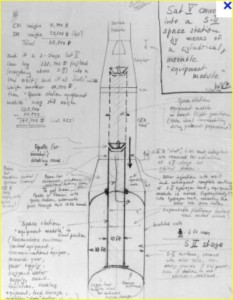 This is when I realized we might need to go to the library to find out more. I found a book by a guy named Goddard who made some early rockets. It had to be a good book because they said he was the Father of Rocketry right on the front cover. One of the first fuels he experimented with was saltpetre mixed with sugar. Eventually, he went on to use liquid oxygen and stuff like that. I decided to give the saltpetre another look because they talked about it in the first couple of chapters of the book. The beginning of the book was the easiest to understand, because each new chapter kept adding more drawings and formulas and diagrams and complicated stuff. Sticking to the first chapter would make things much easier. I admit the saltpetre and sugar didn’t really sound plausible, but the guy had written it in a book, so it had to be right.
This is when I realized we might need to go to the library to find out more. I found a book by a guy named Goddard who made some early rockets. It had to be a good book because they said he was the Father of Rocketry right on the front cover. One of the first fuels he experimented with was saltpetre mixed with sugar. Eventually, he went on to use liquid oxygen and stuff like that. I decided to give the saltpetre another look because they talked about it in the first couple of chapters of the book. The beginning of the book was the easiest to understand, because each new chapter kept adding more drawings and formulas and diagrams and complicated stuff. Sticking to the first chapter would make things much easier. I admit the saltpetre and sugar didn’t really sound plausible, but the guy had written it in a book, so it had to be right. On the scale of explosions, it wouldn’t be considered a huge explosion. In truth, I don’t even remember the sound. I do remember the mushroom cloud that leaped out of my little test tube. It shot up until it hit the ceiling, at which point it started spreading throughout the room. You know how everything seems to be in slow motion during an emergency? It was like that. I watched that demon cloud as it broke free, leaving its signature forever on my mind, indistinguishable from the nuclear bomb blasts we were taught to fear.
On the scale of explosions, it wouldn’t be considered a huge explosion. In truth, I don’t even remember the sound. I do remember the mushroom cloud that leaped out of my little test tube. It shot up until it hit the ceiling, at which point it started spreading throughout the room. You know how everything seems to be in slow motion during an emergency? It was like that. I watched that demon cloud as it broke free, leaving its signature forever on my mind, indistinguishable from the nuclear bomb blasts we were taught to fear. My inquiry soon shifted to another area. What was I going to use for a rocket? I certainly didn’t have any. Anything made of plastic would certainly not work. Rummaging through my dad’s workshop turned up an interesting possibility. It was a cardboard tube about a half-inch in diameter. This was perfect! I had limited permission to use dad’s power tools, so I used the jigsaw to turn a dowel into a nose cone for my rocket. I then taped it into place with electrical tape (none of that scotch tape stuff for us; my dad was an engineer and had all the good stuff). The next problem was wings. How do we make it go straight without wings? I found cardboard on the back of a pad of paper and cut out a triangle. I knew the wing had to handle the high wind speed and high G-forces during the moments after launch. So I used glue to hold my triangular wing in place.
My inquiry soon shifted to another area. What was I going to use for a rocket? I certainly didn’t have any. Anything made of plastic would certainly not work. Rummaging through my dad’s workshop turned up an interesting possibility. It was a cardboard tube about a half-inch in diameter. This was perfect! I had limited permission to use dad’s power tools, so I used the jigsaw to turn a dowel into a nose cone for my rocket. I then taped it into place with electrical tape (none of that scotch tape stuff for us; my dad was an engineer and had all the good stuff). The next problem was wings. How do we make it go straight without wings? I found cardboard on the back of a pad of paper and cut out a triangle. I knew the wing had to handle the high wind speed and high G-forces during the moments after launch. So I used glue to hold my triangular wing in place.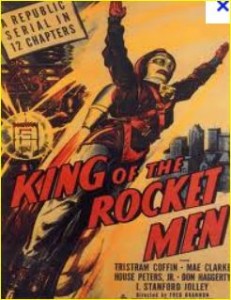
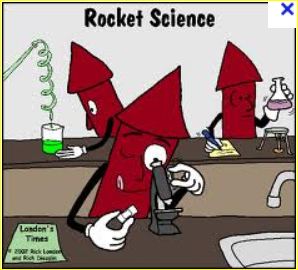 Over the next few months, I experimented with different rocket bodies made from many different substances. I created special wooden nozzles for the rockets that would give greater compression and lift to the rockets. I experimented with different wing designs. I tested different mixes for the rocket fuel, including powder fuel vs. solid fuel. All of these unique rocket designs had one thing in common, which my mom summed up rather well. “They’re just sticks of dynamite with fins glued on,” she said.
Over the next few months, I experimented with different rocket bodies made from many different substances. I created special wooden nozzles for the rockets that would give greater compression and lift to the rockets. I experimented with different wing designs. I tested different mixes for the rocket fuel, including powder fuel vs. solid fuel. All of these unique rocket designs had one thing in common, which my mom summed up rather well. “They’re just sticks of dynamite with fins glued on,” she said.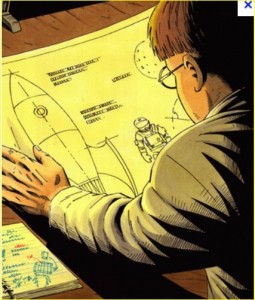 The rocket design changed over time, as you might expect. I eventually settled on a process that involved cutting a wooden dowel into two pieces. The first piece was sharpened to a nice point to ensure minimal air resistance. The second dowel had a hole drilled through the center, which was a technique I designed to increase the rocket’s thrusting power.
The rocket design changed over time, as you might expect. I eventually settled on a process that involved cutting a wooden dowel into two pieces. The first piece was sharpened to a nice point to ensure minimal air resistance. The second dowel had a hole drilled through the center, which was a technique I designed to increase the rocket’s thrusting power. Now, I have to admit what my mom said about my rockets was mostly true (about sticks of dynamite with fins glued on). And you can imagine all the time I spent picking up small bits of paper from exploded rockets that had been blown all over our driveway and lawn. But I wasn’t discouraged. I knew it was just a matter of time before I got it right. And besides, my reputation for rocketry was becoming legendary among my friends. They even started calling me One-Match-Steve. All my friends were of the stick-the-match-sorta-close-and-then-run-away-as-fast-as-you-can types. I, on the other hand, was the only kid stupid enough to hold the match steady until the rocket started burning. It didn’t matter. I wore my new nickname with pride and dignity.
Now, I have to admit what my mom said about my rockets was mostly true (about sticks of dynamite with fins glued on). And you can imagine all the time I spent picking up small bits of paper from exploded rockets that had been blown all over our driveway and lawn. But I wasn’t discouraged. I knew it was just a matter of time before I got it right. And besides, my reputation for rocketry was becoming legendary among my friends. They even started calling me One-Match-Steve. All my friends were of the stick-the-match-sorta-close-and-then-run-away-as-fast-as-you-can types. I, on the other hand, was the only kid stupid enough to hold the match steady until the rocket started burning. It didn’t matter. I wore my new nickname with pride and dignity. That was when things took a turn for the worse. More precisely, the rocket decided it had enough of this “up” stuff and decided to try a little “sideways” stuff. It didn’t like that very much so it quickly switched to “down” stuff and then “over” and “back” stuff. I remember marveling at what an interesting display of zigs and zags was taking place before my eyes. Somewhere out of the corner of my eye, I was aware that Keith was running at top speed in the opposite direction. But I couldn’t be bothered with that now. This was history in the making. I almost forgot to move when one of the zags started heading straight at me. But at the last second, a new zig forced it up. It got about 25 feet up when it began a new maneuver. This one I call a spin-in-place. You often have to develop a new vocabulary to describe the varied takeoff sequences, especially if you haven’t quite worked out some of problems with the wings. So naturally my journal is full of technical terms like “spin-in-place”, “zig zag maneuver”, “twisty”, “shaky”, and “wabbly”.
That was when things took a turn for the worse. More precisely, the rocket decided it had enough of this “up” stuff and decided to try a little “sideways” stuff. It didn’t like that very much so it quickly switched to “down” stuff and then “over” and “back” stuff. I remember marveling at what an interesting display of zigs and zags was taking place before my eyes. Somewhere out of the corner of my eye, I was aware that Keith was running at top speed in the opposite direction. But I couldn’t be bothered with that now. This was history in the making. I almost forgot to move when one of the zags started heading straight at me. But at the last second, a new zig forced it up. It got about 25 feet up when it began a new maneuver. This one I call a spin-in-place. You often have to develop a new vocabulary to describe the varied takeoff sequences, especially if you haven’t quite worked out some of problems with the wings. So naturally my journal is full of technical terms like “spin-in-place”, “zig zag maneuver”, “twisty”, “shaky”, and “wabbly”. At this point, the only other kid with the guts to participate in my advanced research was Keith. We never called him One-Match-Keith, but in his own way, he had courage. He had a chemistry set of his own, and he had access to his sister’s outdoor doll house which we quickly converted to a mobile lab. It was here we hit on the best combination of rocket fuel.
At this point, the only other kid with the guts to participate in my advanced research was Keith. We never called him One-Match-Keith, but in his own way, he had courage. He had a chemistry set of his own, and he had access to his sister’s outdoor doll house which we quickly converted to a mobile lab. It was here we hit on the best combination of rocket fuel.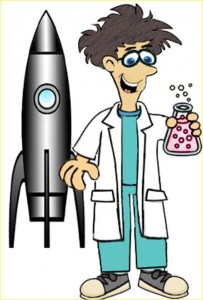 Then came the day we discovered the perfect combination of ingredients. We knew when we finished the cooking process that it had potential, but it wasn’t until we gave it the BB-Fire Test that we knew what we had. Instead of sitting still and producing a nice big flare, this little BB burned so hot and so fast, it launched itself. It didn’t need to be in a rocket or anything. It just flew. And, since we were inside a 6 x 8 foot doll house, the flying BB bounced from wall to wall like a bullet. Keith and I ducked and dodged that flaming pellet from Hell. Eventually, it was quiet. When the smoke cleared out of the doll house, we examined ourselves for burn holes, but it seemed we’d been spared.
Then came the day we discovered the perfect combination of ingredients. We knew when we finished the cooking process that it had potential, but it wasn’t until we gave it the BB-Fire Test that we knew what we had. Instead of sitting still and producing a nice big flare, this little BB burned so hot and so fast, it launched itself. It didn’t need to be in a rocket or anything. It just flew. And, since we were inside a 6 x 8 foot doll house, the flying BB bounced from wall to wall like a bullet. Keith and I ducked and dodged that flaming pellet from Hell. Eventually, it was quiet. When the smoke cleared out of the doll house, we examined ourselves for burn holes, but it seemed we’d been spared.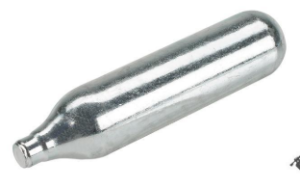 Now in our neighborhood, not all kids are the same. I was a BB gun kid. Some kids had pellet guns, which required you to pump up the air pressure for each pellet. Keith was one of those rare kids who had a CO2 powered pellet gun. When I saw that cool empty CO2 cartridge, I knew we had to do something with it. Nothing this perfectly formed should be thrown away. That’s when I realized it would make the perfect body for a small rocket. It was made of metal! And it already had a natural nozzle built into the end of it. And, if it worked out, we could easily get more of them. Perfect, perfect, perfect!
Now in our neighborhood, not all kids are the same. I was a BB gun kid. Some kids had pellet guns, which required you to pump up the air pressure for each pellet. Keith was one of those rare kids who had a CO2 powered pellet gun. When I saw that cool empty CO2 cartridge, I knew we had to do something with it. Nothing this perfectly formed should be thrown away. That’s when I realized it would make the perfect body for a small rocket. It was made of metal! And it already had a natural nozzle built into the end of it. And, if it worked out, we could easily get more of them. Perfect, perfect, perfect! I stood there in shocked disbelief. There were no little paper shards falling to the ground. That little rocket was gone-gone-gone. And with the force of that explosion, I knew it could have gone anywhere it wanted to go. I looked around the immediate area to see if there was a hunk of exploded metal lying somewhere on the ground. I didn’t see any metal shards, but I did see Keith’s heels as he continued sprinting through the field toward his house.
I stood there in shocked disbelief. There were no little paper shards falling to the ground. That little rocket was gone-gone-gone. And with the force of that explosion, I knew it could have gone anywhere it wanted to go. I looked around the immediate area to see if there was a hunk of exploded metal lying somewhere on the ground. I didn’t see any metal shards, but I did see Keith’s heels as he continued sprinting through the field toward his house. And so, I went into my house. At best it might take a day before their bodies were discovered. But after that, it would be simple to calculate from the hole in the side of the house the direction from which the rocket had come. I knew I needed to put my affairs in order. They would be coming for me soon. But I didn’t want to make it too easy, so I said nothing. I just stoically awaited my fate. When they came for me, I would calmly admit everything. Through that night and all the next day, I waited. Still they did not come. Nor did I see any police cars or ambulances. Nor did I see Keith, although I am sure he watched for police cars from his bedroom window.
And so, I went into my house. At best it might take a day before their bodies were discovered. But after that, it would be simple to calculate from the hole in the side of the house the direction from which the rocket had come. I knew I needed to put my affairs in order. They would be coming for me soon. But I didn’t want to make it too easy, so I said nothing. I just stoically awaited my fate. When they came for me, I would calmly admit everything. Through that night and all the next day, I waited. Still they did not come. Nor did I see any police cars or ambulances. Nor did I see Keith, although I am sure he watched for police cars from his bedroom window. Now, years later, I can’t tell you why, but I never built another rocket after that. Maybe it was because I became interested in girls. Or maybe another hobby came along and displaced my interest in rockets. But I think it was simpler than that. I think there are times in your life when some cosmic force reaches down to give you a good emotional shaking. Kinda like God’s way of saying, “What’s the matter with you? Are you nuts? Stop that!!”
Now, years later, I can’t tell you why, but I never built another rocket after that. Maybe it was because I became interested in girls. Or maybe another hobby came along and displaced my interest in rockets. But I think it was simpler than that. I think there are times in your life when some cosmic force reaches down to give you a good emotional shaking. Kinda like God’s way of saying, “What’s the matter with you? Are you nuts? Stop that!!”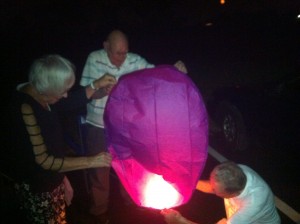 This time, Dad came forward to help. I was pleased. A trained engineer is always a welcome addition in any high-risk endeavor involving fire. Dad watched carefully, like the professional manager he is, leaving the details to other members of his team. This time the launch was flawless. I was busy taking pictures to mark the moment. Ardis was still worried about leaving fingerprints, but I told her that didn’t matter any more because there would be a picture of her doing the deed on the internet within a day. With such evidence, no one needed fingerprints. And no denials were possible.
This time, Dad came forward to help. I was pleased. A trained engineer is always a welcome addition in any high-risk endeavor involving fire. Dad watched carefully, like the professional manager he is, leaving the details to other members of his team. This time the launch was flawless. I was busy taking pictures to mark the moment. Ardis was still worried about leaving fingerprints, but I told her that didn’t matter any more because there would be a picture of her doing the deed on the internet within a day. With such evidence, no one needed fingerprints. And no denials were possible.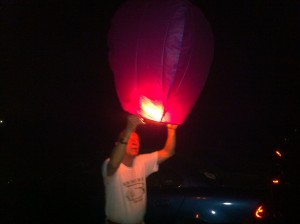 And so went the fourth launch. Absolutely flawless. With a team like this, the Russians would never have beat us in the Space Race.
And so went the fourth launch. Absolutely flawless. With a team like this, the Russians would never have beat us in the Space Race.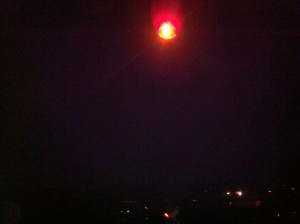 But tonight was our night. We were amazing.
But tonight was our night. We were amazing.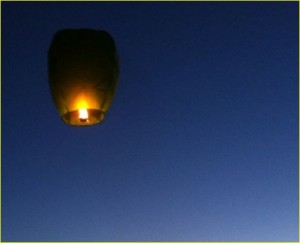 It was windy on the beach, even by Lake Michigan standards, so we gathered to light the first one in the shelter of one of the dunes. I was the self-appointed torch man whose job was to get the fire started. There were 2-3 others who helped hold the lantern upright; the others were busy shouting out instructions and encouragement to the rest of us. The fire wasn’t too hard to start. The real problem was holding the lantern steady and upright so it could fill with the hot air. And, of course, the wind didn’t help. It swirled around us, trying to put the fire out. And then, when the fire was going well, the wind changed tactics and tried to rip the lantern out of our hands. But we didn’t let any of that happen, and slowly, the lantern filled with hot air. Eventually, we knew the time was right, and we released the lantern. And watched as the lantern moved slowly upward into the darkening sky.
It was windy on the beach, even by Lake Michigan standards, so we gathered to light the first one in the shelter of one of the dunes. I was the self-appointed torch man whose job was to get the fire started. There were 2-3 others who helped hold the lantern upright; the others were busy shouting out instructions and encouragement to the rest of us. The fire wasn’t too hard to start. The real problem was holding the lantern steady and upright so it could fill with the hot air. And, of course, the wind didn’t help. It swirled around us, trying to put the fire out. And then, when the fire was going well, the wind changed tactics and tried to rip the lantern out of our hands. But we didn’t let any of that happen, and slowly, the lantern filled with hot air. Eventually, we knew the time was right, and we released the lantern. And watched as the lantern moved slowly upward into the darkening sky.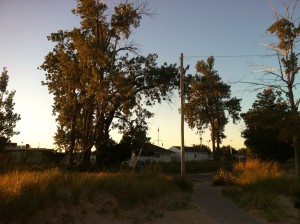 That was when I realized our sky lantern was not heading out over Lake Michigan. To be honest, I knew the wind was blowing north, but I thought it would be shifting toward the north-west, which would have been fine. As I took in more of the surroundings than just the lantern, I realized 1) the lantern was not heading out toward the water, but instead was moving north-east, 2) there is a line of trees in that direction, 3) the trees marked the boundary of the Coast Guard Station, and 4) the wind about 10-20 feet above the ground was moving hard and fast toward the trees. My poor lantern had no chance. He struggled to gain altitude. But the wind held him down. The nasty wind drove our helpless lantern relentlessly on a direct collision course with the trees. There was never really any hope. Our lantern tried to move around the trees, but the wind pushed him this way and that, never waivering from its target. Suddenly, it looked as if the lantern might have out-maneuvered the wind, but then a tree branch reached out and grabbed the lantern and held it tight. My heart sank as I saw my little friend trapped and without hope. Meanwhile, the wind and the tree were busy giving each other high-fives in celebration.
That was when I realized our sky lantern was not heading out over Lake Michigan. To be honest, I knew the wind was blowing north, but I thought it would be shifting toward the north-west, which would have been fine. As I took in more of the surroundings than just the lantern, I realized 1) the lantern was not heading out toward the water, but instead was moving north-east, 2) there is a line of trees in that direction, 3) the trees marked the boundary of the Coast Guard Station, and 4) the wind about 10-20 feet above the ground was moving hard and fast toward the trees. My poor lantern had no chance. He struggled to gain altitude. But the wind held him down. The nasty wind drove our helpless lantern relentlessly on a direct collision course with the trees. There was never really any hope. Our lantern tried to move around the trees, but the wind pushed him this way and that, never waivering from its target. Suddenly, it looked as if the lantern might have out-maneuvered the wind, but then a tree branch reached out and grabbed the lantern and held it tight. My heart sank as I saw my little friend trapped and without hope. Meanwhile, the wind and the tree were busy giving each other high-fives in celebration.
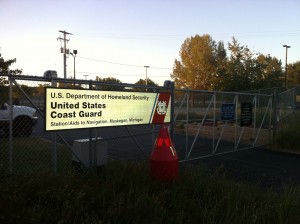 A quick calculation of the wind direction revealed that once again the Coast Guard Station was to be its target. But this time, it would not be a tree. This time, it would be the building itself that would burn. A Coast Guard tree going up in flames might be considered a foolish prank, but a second attempt on the same day would surely brand me as a terrorist. If only it hadn’t been a military installation the wind had chosen. How I hated him for this awful betrayal!
A quick calculation of the wind direction revealed that once again the Coast Guard Station was to be its target. But this time, it would not be a tree. This time, it would be the building itself that would burn. A Coast Guard tree going up in flames might be considered a foolish prank, but a second attempt on the same day would surely brand me as a terrorist. If only it hadn’t been a military installation the wind had chosen. How I hated him for this awful betrayal!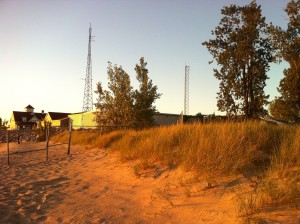 Suddenly, the lantern was pushed down again. It was now only 3-4 feet off the ground. And picking up speed. I saw the fence that surrounds the Coast Guard property. I desperately hoped the lantern would get caught by the fence. Maybe then it would not endanger the lives of the military people living there. Suddenly, the wind began lifting the lantern. That was when I realized the wind’s fiendish plan. The wind had hoped I would give up, thinking the fence would save me. The wind knew I would be stopped by the fence. He also knew he and the lantern could easily sail over it and go on to the building just a few feet away. I, however, would be powerless on this side of the fence, left with nothing to do but watch the building as it burned to the ground. I wondered if I could climb the fence. I also wondered if trespassing on a military base would be excused if I did it to put out a fire. Maybe. But a fire that I caused? Maybe not.
Suddenly, the lantern was pushed down again. It was now only 3-4 feet off the ground. And picking up speed. I saw the fence that surrounds the Coast Guard property. I desperately hoped the lantern would get caught by the fence. Maybe then it would not endanger the lives of the military people living there. Suddenly, the wind began lifting the lantern. That was when I realized the wind’s fiendish plan. The wind had hoped I would give up, thinking the fence would save me. The wind knew I would be stopped by the fence. He also knew he and the lantern could easily sail over it and go on to the building just a few feet away. I, however, would be powerless on this side of the fence, left with nothing to do but watch the building as it burned to the ground. I wondered if I could climb the fence. I also wondered if trespassing on a military base would be excused if I did it to put out a fire. Maybe. But a fire that I caused? Maybe not. For some reason, my friends failed to understand the situation as I did. When I returned to them, still dragging the dead lantern behind me, I did not receive the accolades that were my due. Instead, I was greeted by laughter and ribbing about how fast I had taken off running. Did they not see my heroism and the ultimate sacrifice made by my little friend? Did they not understand the terrible peril that had been averted? Did they not picture me in a federal lockup somewhere?
For some reason, my friends failed to understand the situation as I did. When I returned to them, still dragging the dead lantern behind me, I did not receive the accolades that were my due. Instead, I was greeted by laughter and ribbing about how fast I had taken off running. Did they not see my heroism and the ultimate sacrifice made by my little friend? Did they not understand the terrible peril that had been averted? Did they not picture me in a federal lockup somewhere?